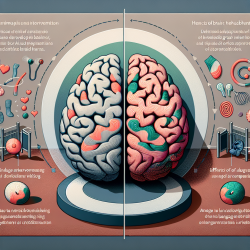Introduction
Childhood speech disorders can significantly impact a child's literacy, academic success, and social well-being. Among these, Childhood Apraxia of Speech (CAS) is particularly challenging, affecting approximately 1 in 1000 children. Recent research, including the study titled "Genetic architecture of childhood speech disorder: a review," has shed light on the genetic underpinnings of CAS, offering new avenues for diagnosis and treatment. This blog explores how practitioners can leverage these insights to improve therapeutic outcomes for children with speech disorders.
The Genetic Breakthrough
Historically, the genetic basis of speech disorders was recognized as early as the 1950s, but it wasn't until 2001 that the first causative gene, FOXP2, was identified. The recent study reviewed here has expanded this knowledge significantly, identifying over 30 causative genes for CAS. These findings highlight that approximately one in three children with CAS have a genetic variant that explains their condition, with significant genetic heterogeneity emerging.
Implications for Practitioners
Understanding the genetic architecture of CAS opens the door to precision diagnosis and therapies. Here are some actionable insights for practitioners:
- Implement Genetic Testing: Given the high diagnostic yield, genetic testing should be considered for children with CAS. This aligns with practices for other neurodevelopmental disorders and can guide targeted interventions.
- Personalize Therapy Plans: With knowledge of specific genetic variants, therapy can be tailored to address the unique needs of each child, potentially improving outcomes.
- Monitor Comorbid Conditions: Many genes associated with CAS are also linked to other neurodevelopmental disorders such as autism and epilepsy. Practitioners should be vigilant for these comorbidities to provide comprehensive care.
Encouraging Further Research
While significant progress has been made, further research is essential to fully understand the genetic mechanisms underlying CAS and other speech disorders. Practitioners are encouraged to stay informed about ongoing research and consider participating in studies that contribute to this growing body of knowledge.
Conclusion
The genetic insights into CAS offer a promising path toward more effective diagnosis and treatment. By integrating genetic testing into clinical practice and tailoring interventions based on genetic profiles, practitioners can enhance therapeutic outcomes for children with speech disorders. To explore the detailed findings of the research, practitioners can access the original paper: Genetic architecture of childhood speech disorder: a review.










